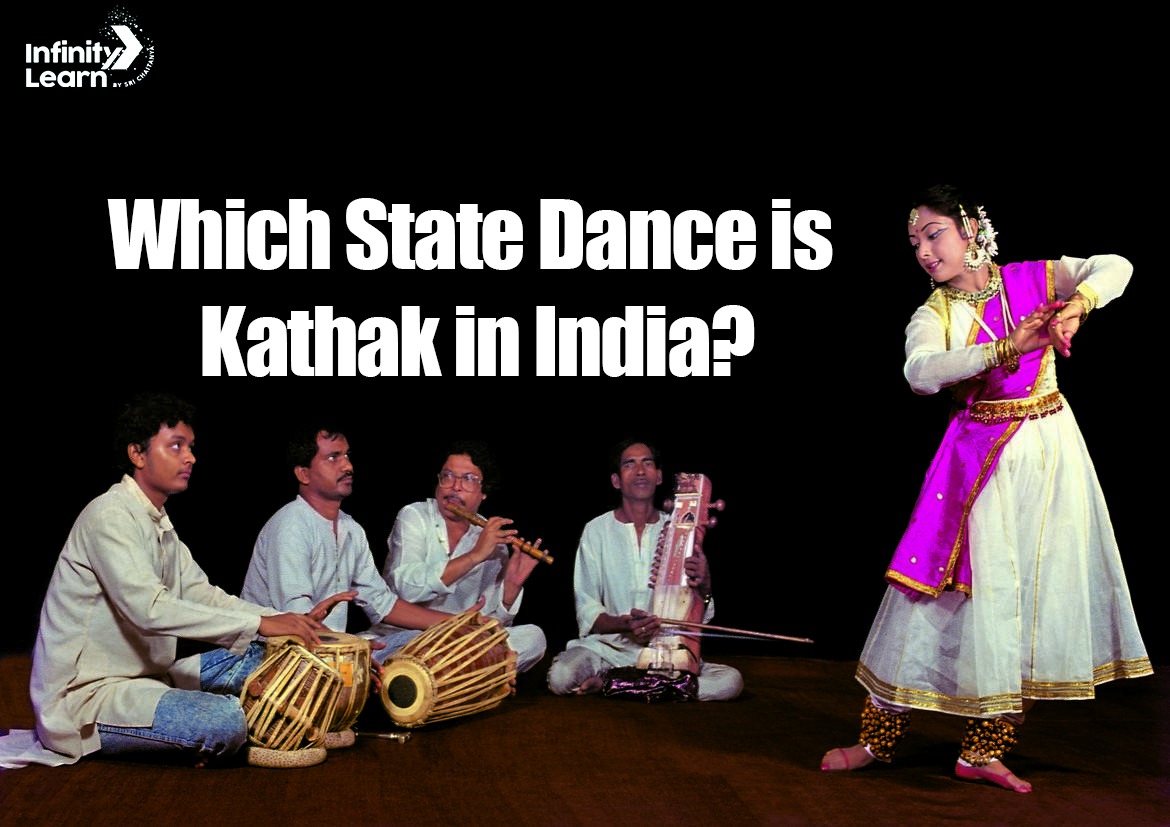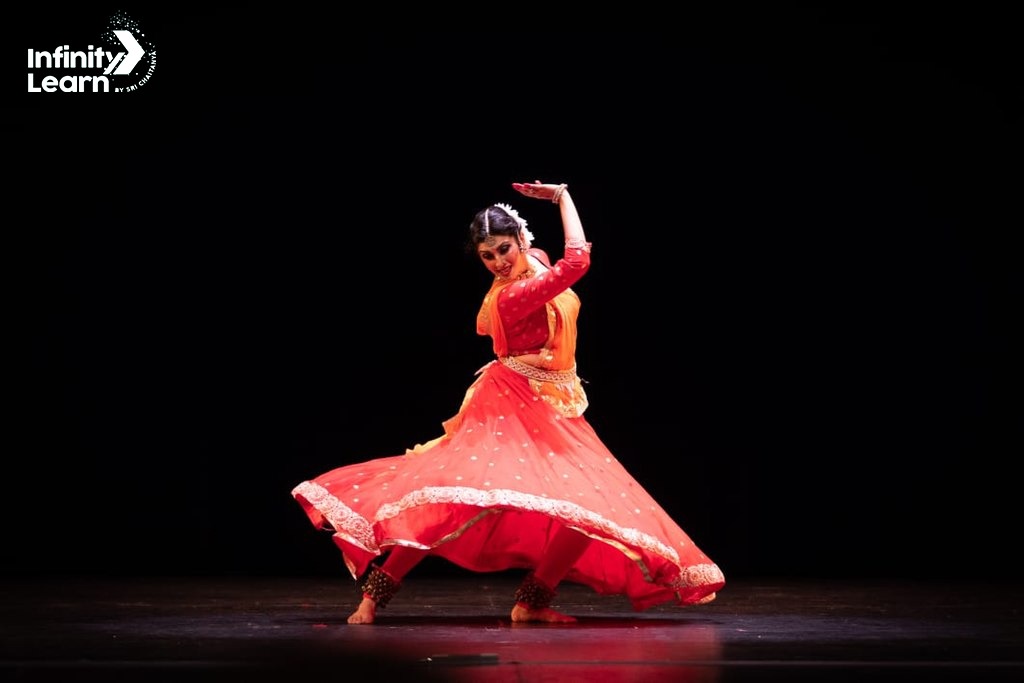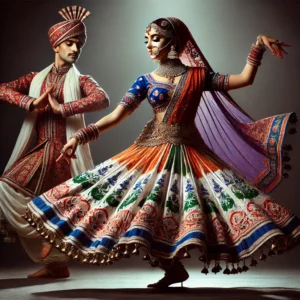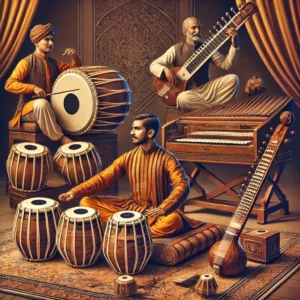Table of Contents
Kathak is one of the eight classical dance forms of India, and it carries with it a rich history of cultural heritage, evolution, and artistic expression. In this article, we’ll explore everything you need to know about Kathak dance, from its origins to its unique features, and why it remains an important and influential art form. This guide will be ideal for beginners who are interested in learning about Kathak, its origins, and its significance in Indian culture.
What is Kathak?
Kathak is a classical Indian dance form that originated in the state of Uttar Pradesh, specifically in the northern region of India. It is known for its graceful movements, intricate footwork, expressive gestures, and storytelling abilities. The word ‘Kathak’ is derived from the Sanskrit word ‘Katha’, which means story, and ‘Kathakar’, meaning one who tells a story. This art form is known for narrating stories through expressive dance, movements, and rhythmic footwork, often accompanied by music.

Which State is Kathak Dance Associated With in India?
Kathak dance is primarily associated with the state of Uttar Pradesh in India. Although Kathak has roots that spread across various parts of northern India, Uttar Pradesh is considered its cultural heartland. This classical dance form flourished in the courts of the Nawabs of Awadh (present-day Lucknow, Uttar Pradesh), where it evolved into the elegant and expressive art form we see today.
Kathak dance reflects the rich cultural heritage of Uttar Pradesh, showcasing the state’s historical connection with music, dance, and storytelling. Over the years, Kathak has integrated elements from neighboring regions, especially Rajasthan, due to its geographical closeness. This blend of cultural influences has led to the development of various gharanas or distinct schools within the Kathak tradition.
While Kathak dance is closely linked with Uttar Pradesh, it is important to note that it is practiced and performed across India and beyond, making it one of the most popular and widely recognized classical dance forms. The dance form has evolved to incorporate elements from various cultures and regions, yet its roots in Uttar Pradesh remain strong, preserving its traditional essence.
In summary, if you’re wondering “Kathak dance which state?” the answer is predominantly Uttar Pradesh, where the dance form has flourished and continues to be a vital part of the state’s cultural identity.
History of Kathak Dance
Early Beginnings (Hindu Temples)
Kathak’s history dates back to the ancient Indian tradition of storytelling through dance. Originally, the dancers (Kathakars) performed in temples, narrating religious stories and mythological tales from Hindu texts like the Mahabharata and Ramayana. These performances were a way to convey moral lessons and cultural stories to the masses, as many people were not literate.
Evolution under Mughal Influence
As the Mughal Empire expanded, Kathak underwent significant transformation. During this period, Kathak moved away from purely religious narratives to more courtly performances. Kathak dancers in Mughal courts began to focus on grace, storytelling, and more sophisticated choreography. The influence of Persian, Turkish, and Afghan cultures brought about intricate movements and a more delicate, rhythmic approach.
Modern-Day Kathak
Today, Kathak is practiced worldwide, with both traditional and modern adaptations. It has transformed from a temple art form to a sophisticated stage performance that appeals to a global audience. Modern Kathak performances continue to incorporate elements from its rich heritage, while also exploring new themes and experimental choreography.
Kathak Today
Today, Kathak is one of the eight officially recognized classical dance forms of India. It continues to be a popular and dynamic art form, practiced and performed not only in India but around the world. “Kathak Dance Which State Is It Associated With?” is a question that is often asked. Its profound roots in Uttar Pradesh, where it developed and flourished, provide the explanation. Modern Kathak performances often blend traditional elements with contemporary themes, keeping the dance form relevant and appealing to new generations. Despite these innovations, the essence of Kathak—its storytelling, intricate footwork, and expressive gestures—remains unchanged, preserving the rich cultural heritage of “Kathak Dance which state” is predominantly Uttar Pradesh, yet it resonates globally.
Elements of Kathak Dance
Kathak dance is a blend of three essential elements:
- Nritta: This is the pure dance element of Kathak, focusing on intricate footwork and graceful spins (chakkars). The dancer performs complex rhythmic patterns that synchronize perfectly with the beats of the accompanying music.
- Nritya: This component tells a tale or expresses an emotion through dancing combined with expressions and gestures (mudras). An important aspect of telling stories from Indian mythology, especially those involving Radha and Krishna, is the dancer’s facial expressions.
- The term “Natya” describes the dramatic side of Kathak dance, in which the dancer assumes the role of a storyteller and frequently plays figures from epics like the Ramayana and Mahabharata. This component gives the dance life, resulting in a captivating and participatory performance.
Gharanas of Kathak
Kathak has evolved into three main schools, or gharanas, each with its own unique style and emphasis:
- The Lucknow Gharana is characterized by its emphasis on grace, elegance, and expressiveness. It originated in the Awadh courts of the Nawabs. The delicate representation of emotions and sensitivity are hallmarks of the Lucknow style.
- The Jaipur Gharana is characterized by its intricate footwork and powerful, forceful gestures. The Jaipur style is a very kinetic form of Kathak that heavily emphasizes rhythm and quick spins.
- Benaras Gharana: Also referred to as the Varanasi Gharana, this fashion combines aspects of the gharanas of Jaipur and Lucknow. It places equal emphasis on technique and expressiveness, with a concentration on floor work and the religious elements of dance.
Costumes of Kathak Dance
The costumes worn by Kathak dancers are as elegant and expressive as the dance itself. They typically include:
- Female Dancers: Women usually wear a traditional lehenga-choli or anarkali suit, which is a long, flowing dress with a fitted bodice and wide skirt. The costume features intricate embroidery and mirrors, and the dancer drapes a dupatta (scarf) around their shoulders or over their head.
- Male Dancers: Men typically wear an angarkha, a long tunic that can be either knee-length or ankle-length, paired with churidar (tight-fitting trousers). They may also wear a turban and a dupatta draped across the chest.
- Jewelry: Both male and female dancers often wear traditional jewelry, including bangles, anklets (ghungroos), and earrings. The anklets are particularly significant as they produce sound when the dancer performs intricate footwork.
Music and Instruments that Accompany a Kathak Performance
Kathak performances are typically accompanied by a rich array of musical instruments, which enhance the storytelling and emotional depth of the dance. The primary instruments include:
- Tabla: A pair of hand drums that provide the rhythmic foundation for the dance.
- Harmonium: A keyboard instrument that offers melodic support.
- Sarangi: A stringed instrument that is known for its soulful and evocative sound.
- Pakhawaj: A barrel-shaped drum that adds depth to the rhythmic patterns.
- Sitar: A plucked string instrument that is occasionally used to complement the performance.
Popular Kathak Dancers
Kathak has been graced by several legendary performers who have brought the dance form to global prominence. Some of the most celebrated Kathak dancers include:
- Pandit Birju Maharaj: A maestro of the Lucknow Gharana, Birju Maharaj is considered one of the most popular Kathak dancers of all time.
- Sitara Devi: Known as the “Empress of Dance,” Sitara Devi was a renowned dancer of the Benaras Gharana and contributed immensely to the popularization of Kathak.
- Shovana Narayan: A prominent Kathak dancer of the present era, Shovana Narayan is known for her innovative performances and dedication to the art form.
- Kumudini Lakhia: A dancer and choreographer who has made significant contributions to the contemporary understanding of Kathak.
Performance Structure of Kathak Dance

A typical Kathak performance follows a structured format, usually starting with an invocation or a vandana, followed by:
- Thaat: The initial stance where the dancer poses gracefully, setting the tone for the performance.
- Aamad: The formal entry of the dancer onto the stage, characterized by graceful movements.
- Tora and Tukra: Short rhythmic pieces that showcase the dancer’s mastery over footwork.
- Gat: A stylized walk or movement that depicts a particular scene or character.
- Tatkaar: The footwork patterns, which are an integral part of Kathak, performed with precision and speed.
- Jugalbandi: A playful interaction between the dancer and the accompanying musician, typically the tabla player.
- Bhajan or Thumri: The performance may conclude with a devotional song (bhajan) or a semi-classical piece (thumri), where the dancer expresses emotions through abhinaya (expression).
10 Lines on Kathak Dance
- Kathak is a classical dance form originating from northern India, particularly Uttar Pradesh.
- It is characterized by intricate footwork, graceful spins, and expressive storytelling.
- Kathak has three main gharanas: Lucknow, Jaipur, and Benaras, each with its own style.
- The dance is often performed in temples and courts and has a rich historical background.
- Female dancers typically wear anarkali suits, while male dancers wear angarkhas.
- Kathak performances are accompanied by instruments like the tabla, harmonium, and sarangi.
- The dance is deeply connected to Indian classical music, especially Hindustani classical music.
- Pandit Birju Maharaj is one of the most famous Kathak dancers.
- The performance structure includes elements like thaat, aamad, gat, and jugalbandi.
- Kathak is a vibrant and expressive dance form that continues to evolve and inspire.
Kathak Dance Key Features
Kathak is known for its distinct features, which set it apart from other classical dance forms. The main characteristics include:
1. Footwork (Tatkar)
One of the most defining elements of Kathak is its intricate and rhythmic footwork. The dancer wears ghungroos (bells) around their ankles, which create sound as they move. These foot movements are precisely timed to the beat of the music, and they form the backbone of the dance.
2. Expressive Hand Gestures (Mudras)
Kathak incorporates many hand gestures, or mudras, that convey emotions and tell stories. These gestures can represent various themes such as nature, animals, deities, or abstract concepts.
3. Storytelling (Abhinaya)
Kathak dance is primarily about narration. The dancer uses facial expressions, body movements, and gestures to tell a story. The narratives often draw from mythology, religious texts, or historical events, making storytelling a vital aspect of the performance.
4. Rhythmic Movements (Laya and Taal)
Kathak dancers are trained to master the rhythm (known as laya) and the cycle of beats (called taal). Kathak is unique for its use of fast-paced rhythmic patterns, which are synchronized with the dancer’s footwork and hand gestures. The most common taal in Kathak is Teentaal, a 16-beat cycle.
Instruments Used in Kathak
Kathak performances are accompanied by various traditional instruments. The most common instruments used in Kathak include:
- Tabla: A pair of drums used for rhythm
- Sitar: A stringed instrument used for melody
- Harmonium: A hand-pumped organ used to provide musical accompaniment
- Sarangi: A stringed instrument that adds depth to the performance
- Pakhawaj: A double-headed drum used in traditional Kathak
These instruments provide the music that complements the dancer’s movements and expressions.
How to Learn Kathak
For beginners interested in learning Kathak, it’s important to start with the basics:
- Footwork: Begin by practicing basic foot movements and rhythms.
- Posture: Kathak requires a specific stance, so mastering the correct posture is crucial.
- Mudras: Learn basic hand gestures that are the foundation of storytelling.
- Expression: Focus on facial expressions to convey emotions and narrative.
It’s recommended to take classes with a certified instructor who specializes in Kathak to ensure proper training and technique.
Conclusion
Kathak, a classical dance form with roots in northern India, is a beautiful expression of rhythm, storytelling, and culture. Kathak caters to everyone with its diverse styles. If you appreciate the detailed footwork of the Jaipur Gharana, the graceful expressions of the Lucknow Gharana, or the devotional elements of the Benaras Gharana, you’ll find something to enjoy. Its rich history, vibrant costumes, and powerful music make it one of India’s most beloved dance forms. As Kathak continues to evolve, it remains a testament to India’s diverse and dynamic cultural heritage.
Kathak Dance Which State FAQs
From which State is Kathak Dance Associated?
Kathak is traditionally associated with the northern regions of India. It initially originated in the state of UP.
Is Kathak a dance of Kerala?
No, Kathak is not a dance of Kerala. It is a classical dance form originating from Uttar Pradesh.
Which city is Kathak from?
Kathak has its roots in the city of Varanasi, which is located in Uttar Pradesh.
Are Kathak and Bharatanatyam the same?
No, Kathak and Bharatanatyam are not the same. Kathak originates from North India, specifically Uttar Pradesh, while Bharatanatyam is from South India, particularly Tamil Nadu. They differ in style, technique, and presentation.
Which state festival is Bharatanatyam?
Bharatanatyam is performed during various festivals and cultural events in Tamil Nadu. It is especially showcased during festivals like Pongal and other traditional celebrations.











